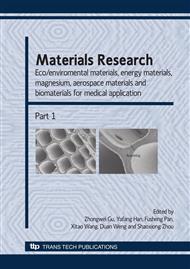p.991
p.999
p.1003
p.1011
p.1017
p.1022
p.1026
p.1034
p.1039
Functionality of Ti-O Thin Films Doped by Phosphorus: Wettability, Semiconductor Performance and Blood Compatibility
Abstract:
For an application as biomedical materials of high performance with a good biocompatibility, the Ti-O film on Si (110) wafer substrate has been synthesize by means of unbalance reactive magnetron sputtering method and modified by phosphorus ion implantation and succeeding vacuum annealing. X-ray diffraction (XRD) results indicated that such prepared Ti-O film had a rutile structure. X-ray photoelectron spectroscopy (XPS) analysis demonstrates the effect of P ion doping. The contact angle test and sheet resistance results showed that titanium oxide film and phosphorus-doped titanium oxide film became more hydrophilic and higher conductance after annealing. The morphology and roughness of the surface have been investigated using SEM. Antithrombotic property of the titanium oxide thin film was examined by platelet adhesion tests. The results showed that the undoped Ti-O films and the P implant and annealing at 900 °C Ti-O film had good blood compatibility.
Info:
Periodical:
Pages:
1017-1021
Citation:
Online since:
January 2009
Authors:
Keywords:
Price:
Сopyright:
© 2009 Trans Tech Publications Ltd. All Rights Reserved
Share:
Citation:


